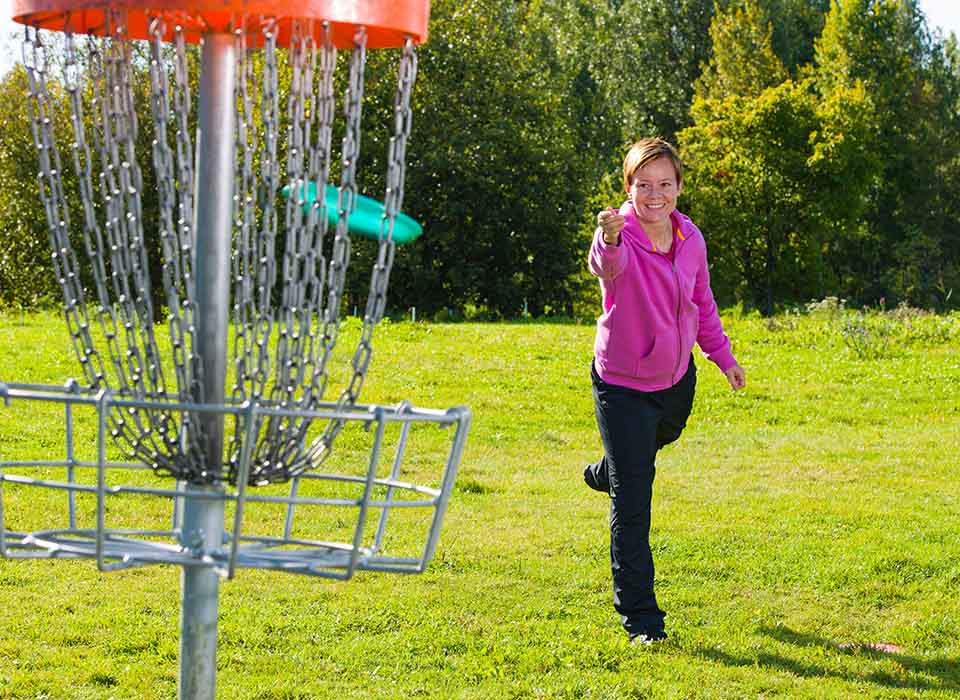Have you ever seen those chain baskets at a local park and wondered what they were? Have you ever seen a group of people throwing frisbee discs long distances trying to land it in baskets? These people are most likely playing a game of disc golf!
In regular golf, players try to get their balls in the hole in the fewer number of strokes. In disc golf, players aim to get their disc into the basket in the least number of throws.
The course has three sections: the tee, the fairway, and the basket. The tee area is often marked by a variation in the color on the ground or otherwise has a boundary marked. Each player begins their turn from behind the tee area and continues down the fairway, each time throwing from where their disc landed from the earlier throw. The fairway is the area between the tee and the basket, and it can look different depending on the course. Some courses are in wooded areas while others may be out in the open like a normal golf course. The round is over once every player has landed their disc in the chain basket. While there are few rules to the game, there is an unspoken etiquette that other players should remain quiet, still and out of the way while discs are being thrown. The main purpose of disc golf is to get players together, moving and outside.
For beginners, the hardest part is finding the right discs and learning the terminology. Look below to find our tips on which discs to use and some of the basic terms.
Discs
The biggest tip given to beginners is to try out a variety of discs. You can compare brands, weight and stability ratings to find the perfect discs for you.
Heavier discs are more stable in the air and will fly straighter. The more experienced players usually play with heavier discs with beginners starting out with lighter weight discs.
The stability of a disc moves on a scale from (-3) to (3). Discs with a stability of 0 tend to fly straight and low and are used as putters when players get near the basket, just like golfers use putters on the green near the hole. Discs with stability in the negative numbers, -3 to -1, are called under stable discs. They always fade, or veer, to the right, even when players try to throw them straight. Over stable discs have the positive numbers 1 to 3 and fade to the left. While both over and under stable discs are used for long drives and mid-range throws, there is a difference between them. Players should use the stability rating to help decide how the disc should be thrown, either over or under hand. Players must choose a disc that will fit their needs and the specific course they’re playing on.
There are three types of discs: drivers, mid-range and putters. The driver is used for long distances. The mid-range discs are the ones that are the most precise and you want to find one that does not flip or roll when thrown. The putter is used for close range throws which means they are usually used at the end of a hole. These putter discs should be very stable and should be able to handle lots of wind. If you are a beginner who is feeling overwhelmed by the options, many brands sell sets that include one of each.
Terminology
Completion (of hole): Each hole has a chain basket at the end. To complete the hole each player must get their disc into the chain basket.
Fairway Throw: When you’re on the fairway you can move with the throw, you can run up to the lie and throw if you release the disc before the lie, movement is not allowed within 10 meters or 30 feet of the hole
Lie: The spot where a player’s disc lands is marked with a mini disc or overturned regular disc. The next throw must be made from this spot.
Out-of-Bounds: Certain areas of the course are off limits to throw in or out of (ex: water features or public roads). If the disc goes into these areas, then they must move their disc three feet in bounds and continue their play. A penalty stroke is added to the score for that hole. Stroke/Point: Each attempt to get closer to the hole or basket. One stroke is recorded each throw, and the goal is to get as few strokes as possible.
Tee Throw: The beginning of each hole begins with a tee. The first throw must begin inside or behind the designated tee area.
Throwing Order: There is no set rule on how to decide the throwing order at the beginning of a game. Once the first hole is complete, the person with the lowest total stroke count throws first.
Unplayable Lie: When a lie that can’t be played due to environmental problems (bush, water, tree etc.) causes players to move their disc to a playable spot that is not any closer to the hole.

